Tamron SP 10-24mm f/3.5-4.5 DiII
Tamron introduced the first super, super zoom, so it was no surprise that they would stretch the limits of the ultra wide-angle zoom, not only that but they've now introduced their second version. And here we take a look at the lens that's a prime target for lovers of landscape and architecture photography.
Tamron SP AF10-24mm f/3.5-4.5 Di-II LD Aspherical [IF]: Specifications
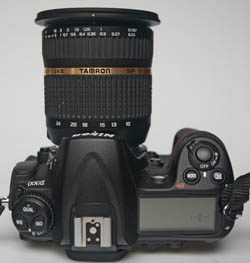
First a quick note about the Di lens format. They are designed for use on digital SLRs and feature an improved coating technology with anti-reflection designs to cope with stronger internal reflections that may be created inside the mirror box of the camera or from light bouncing off the CCD or CMOS sensors which are almost mirror-like on their surface..
Many larger sensor digital cameras have an automatic sensor crop so you view the safe/recorded area. On any other camera you could crop the result, but it means you wouldn't get the benefit of all those extra pixels you paid for and you may miss out on detail around the edges that you hadn't compensated for.
So we're looking at a 10-24mm zoom range. Because of this crop you get the 35mm equivalent of 16mm to 38.5mm wide-angle on a Canon with a 1.6x magnification and 15-36mm on a Nikon, Sony or Pentax with a 1.5x sensor magnification.
Those who've done some basic research will have noted that Tamron has the edge over the independent competition. Sigma manage to match the wide end with their 10-20mm and Tokina match the longer end with their 12-24mm, but here we have the best of both worlds.
The lens has 7 blades which gives decent bokeh, but not as good as the Tokina which has 9 blades or the Canon 10-22mm with a circular aperture. The Sigma falls short here with just 6 blades.
The Tamron 10-24mm has the same 77mm filter thread adopted by all the super wide zoom lenses. It's quite costly to kit out with the usual skylight and polariser.
We're testing the lens in Nikon AF fit on a D300 body. The lens has all the electronic couplings to perform the various advanced metering and focusing options the D300 camera provides. The same goes for all the versions - you should get full compatibility with any camera currently made.
We are also using a Pentax K7 with the Pentax 12-24mm lens to gain some extra comparison data.
Tamron SP AF10-24mm f/3.5-4.5 Di-II LD Aspherical [IF]: Build and Handling
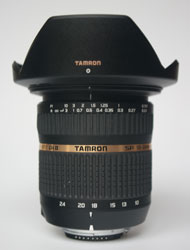 This Tamron lens is relatively compact and our test sample weighs 428 grams without hood (spec says 406g)
This Tamron lens is relatively compact and our test sample weighs 428 grams without hood (spec says 406g)
This is much lighter than the Tokina at 570g and Sigma at 470g. So not only do you get more focal length it's lighter to carry. This reduced weight hasn't compromised build quality. and it still feels substantial in the hand.
The zoom and focus rings are large and easy to handle with rubberised grips. The zoom has a light squeak as you rotate through the range which is a little annoying in quiet locations. The focusing ring adjusts with a good amount of friction in manual and handles well in AF on the camera.
Like most lenses these days the aperture ring has been omitted.
The lens mounting marker is large and bold so you don't spend ages aligning to attach to the camera.
Tamron SP AF10-24mm f/3.5-4.5 Di-II LD Aspherical [IF]: Performance
We found the lens focuses quickly and precisely on the D300 and it's relatively quiet. You can use it with the built in flash to around 16mm - anything wider and you see a curved shadow of the top of the lens on the bottom edge of the photo.

 Here are some results taken with the lens that illustrate various performance points.
Here are some results taken with the lens that illustrate various performance points.
This pair of photos shows the range of the lens (10mm left and 24mm right) and the minimal amount of distortion. You will see a small amount of curving on the left photo, but this is down to the extreme angle and is normal.
The lens tends to perform better at the longer settings. Look at the sign and you'll see the word Priory has slightly sharper edges on the right hand photo.
Close focus is something that can be very important, especially if this is the only lens you are out and about with. A lens of this type is not designed for macro, so don't expect frame-filled insect shots. The photo below shows the capability of the lens at its closest focus. And in comparison we've included the same shot on the Pentax 12-24mm which has a similar build and performance to the Tokina.
The toy car is about 80mm (3 inches) wide. This shows the Tamron has a useful macro, not great for insects but fine for larger subjests such as flowers, and better than the Pentax option. The lens was focused on the lamp in the centre of the frame.

 When the Tamron is at its widest angle setting it's perfect for creating dramatic ultra wide-angle shots. And at these extremes you may expect to see some lens vignetting, but this lens has even coverage across the frame. In both these example you would see the exposure slightly darker at the corners but the lens is even.
When the Tamron is at its widest angle setting it's perfect for creating dramatic ultra wide-angle shots. And at these extremes you may expect to see some lens vignetting, but this lens has even coverage across the frame. In both these example you would see the exposure slightly darker at the corners but the lens is even.
The left hand shot was with the camera pointing up from the ground in a field of corn. The right hand shot shows the typical dramatic perspective that an ultra wide can deliver. Some other reviews have commented on the lack of sharpness with this lens but that's certainly not evident so far.
Now looking at sharpness in detail - the camera was mounted on a tripod and the focus point was the face of the volume knob. The widest aperture and then the smallest aperture were selected on each lens so you can compare sharpness from the Pentax and Tamron.
At the widest aperture (top pair) some detail is lost on the score sheet as it's out of the range covered by the depth-of-field, but look at the volume button. There's nothing wrong with shaprness here. And, if anything, it's a touch better than the Pentax.
And then stopped down, so depth-of-field ensures everything is sharper, shows that at close range with fine detail this Tamron is a real competent performer.
These two shots below show how the lens copes with flare.
Tamron SP AF10-24mm f/3.5-4.5 Di-II LD Aspherical [IF]: Verdict
The Tamron 10-24mm is a worthy wide angle option. It will suite both landscape and building photographers. There's minimal distortion and it's competently sharp across the focal lengths. It's not brilliant fully open, but more than adequate for most users. I can see this being the kit lens of estate agent photographers as the range is perfect for the standard exterior shot and will cope with most interiors too. It's build quality is good, apart from the light squeak on the zoom. With a bigger range than the competition, a good performance and a more competitive price, this lens makes lots of sense.
Tamron SP AF10-24mm f/3.5-4.5 Di-II LD Aspherical [IF]: Plus Points
 Lighter weight
Lighter weight
 Wide zoom range
Wide zoom range
 Price
Price
Tamron SP AF10-24mm f/3.5-4.5 Di-II LD Aspherical [IF]: Minus Points
 Noisy zoom (possibly just our review model)
Noisy zoom (possibly just our review model)
 Small amount of chromatic aberration at the extremes of the frame
Small amount of chromatic aberration at the extremes of the frame
 Slightly soft when shooting into the sun.
Slightly soft when shooting into the sun.
FEATURES

HANDLING

PERFORMANCE

OVERALL

Review by Peter Bargh, ePHOTOzine
The Tamron SP AF10-24mm f/3.5-4.5 Di-II LD Aspherical [IF] costs around £380 and is available from Warehouse Express here: Tamron SP AF10-24mm f/3.5-4.5
Tamron SP AF10-24mm f/3.5-4.5 Di-II LD Aspherical [IF]: Specifications
- Focal length: 10-24mm
- Max aperture: f/3.5-4.5
- Min aperture: f/22
- Angle of view: 108° 44’ – 60° 20’ (APS-C size equivalent)
- Filter diameter: 77mm
- Lens construction: 12 elements in 9 groups
- No. of diaphragm blades: 7
- Closest focus: 0.24m
- Maximum magnification ratio: 1:5.1 (at 24mm)
- Diameter x length: 83.2mm x 86.5mm
- Weight: 406g
- Hood: Flower-shaped lens hood
- Mount: Canon, Nikon, Pentax, Sony

First a quick note about the Di lens format. They are designed for use on digital SLRs and feature an improved coating technology with anti-reflection designs to cope with stronger internal reflections that may be created inside the mirror box of the camera or from light bouncing off the CCD or CMOS sensors which are almost mirror-like on their surface..
Many larger sensor digital cameras have an automatic sensor crop so you view the safe/recorded area. On any other camera you could crop the result, but it means you wouldn't get the benefit of all those extra pixels you paid for and you may miss out on detail around the edges that you hadn't compensated for.
So we're looking at a 10-24mm zoom range. Because of this crop you get the 35mm equivalent of 16mm to 38.5mm wide-angle on a Canon with a 1.6x magnification and 15-36mm on a Nikon, Sony or Pentax with a 1.5x sensor magnification.
Those who've done some basic research will have noted that Tamron has the edge over the independent competition. Sigma manage to match the wide end with their 10-20mm and Tokina match the longer end with their 12-24mm, but here we have the best of both worlds.
The lens has 7 blades which gives decent bokeh, but not as good as the Tokina which has 9 blades or the Canon 10-22mm with a circular aperture. The Sigma falls short here with just 6 blades.
The Tamron 10-24mm has the same 77mm filter thread adopted by all the super wide zoom lenses. It's quite costly to kit out with the usual skylight and polariser.
We're testing the lens in Nikon AF fit on a D300 body. The lens has all the electronic couplings to perform the various advanced metering and focusing options the D300 camera provides. The same goes for all the versions - you should get full compatibility with any camera currently made.
We are also using a Pentax K7 with the Pentax 12-24mm lens to gain some extra comparison data.
Tamron SP AF10-24mm f/3.5-4.5 Di-II LD Aspherical [IF]: Build and Handling
 This Tamron lens is relatively compact and our test sample weighs 428 grams without hood (spec says 406g)
This Tamron lens is relatively compact and our test sample weighs 428 grams without hood (spec says 406g)This is much lighter than the Tokina at 570g and Sigma at 470g. So not only do you get more focal length it's lighter to carry. This reduced weight hasn't compromised build quality. and it still feels substantial in the hand.
The zoom and focus rings are large and easy to handle with rubberised grips. The zoom has a light squeak as you rotate through the range which is a little annoying in quiet locations. The focusing ring adjusts with a good amount of friction in manual and handles well in AF on the camera.
Like most lenses these days the aperture ring has been omitted.
The lens mounting marker is large and bold so you don't spend ages aligning to attach to the camera.
Tamron SP AF10-24mm f/3.5-4.5 Di-II LD Aspherical [IF]: Performance
We found the lens focuses quickly and precisely on the D300 and it's relatively quiet. You can use it with the built in flash to around 16mm - anything wider and you see a curved shadow of the top of the lens on the bottom edge of the photo.

 Here are some results taken with the lens that illustrate various performance points.
Here are some results taken with the lens that illustrate various performance points.This pair of photos shows the range of the lens (10mm left and 24mm right) and the minimal amount of distortion. You will see a small amount of curving on the left photo, but this is down to the extreme angle and is normal.
The lens tends to perform better at the longer settings. Look at the sign and you'll see the word Priory has slightly sharper edges on the right hand photo.
Close focus is something that can be very important, especially if this is the only lens you are out and about with. A lens of this type is not designed for macro, so don't expect frame-filled insect shots. The photo below shows the capability of the lens at its closest focus. And in comparison we've included the same shot on the Pentax 12-24mm which has a similar build and performance to the Tokina.
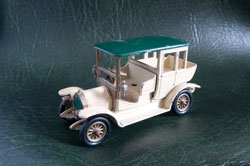 | 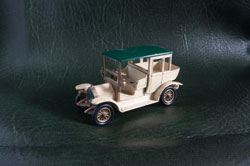 |
| Tamron 10-24mm at its closest focus | Pentax 12-24mm at its closest focus |

 When the Tamron is at its widest angle setting it's perfect for creating dramatic ultra wide-angle shots. And at these extremes you may expect to see some lens vignetting, but this lens has even coverage across the frame. In both these example you would see the exposure slightly darker at the corners but the lens is even.
When the Tamron is at its widest angle setting it's perfect for creating dramatic ultra wide-angle shots. And at these extremes you may expect to see some lens vignetting, but this lens has even coverage across the frame. In both these example you would see the exposure slightly darker at the corners but the lens is even. The left hand shot was with the camera pointing up from the ground in a field of corn. The right hand shot shows the typical dramatic perspective that an ultra wide can deliver. Some other reviews have commented on the lack of sharpness with this lens but that's certainly not evident so far.
Now looking at sharpness in detail - the camera was mounted on a tripod and the focus point was the face of the volume knob. The widest aperture and then the smallest aperture were selected on each lens so you can compare sharpness from the Pentax and Tamron.
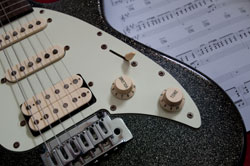 | 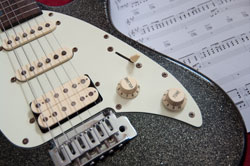 |
| Tamron 10-24mm at f/3.5 | Pentax 12-24mm at f/4 |
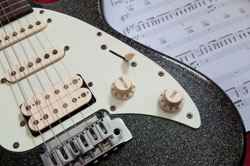 | 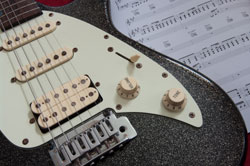 |
| Tamron 10-24mm at f/25 | Pentax 12-24mm at f/22 |
And then stopped down, so depth-of-field ensures everything is sharper, shows that at close range with fine detail this Tamron is a real competent performer.
These two shots below show how the lens copes with flare.
Tamron SP AF10-24mm f/3.5-4.5 Di-II LD Aspherical [IF]: Verdict
The Tamron 10-24mm is a worthy wide angle option. It will suite both landscape and building photographers. There's minimal distortion and it's competently sharp across the focal lengths. It's not brilliant fully open, but more than adequate for most users. I can see this being the kit lens of estate agent photographers as the range is perfect for the standard exterior shot and will cope with most interiors too. It's build quality is good, apart from the light squeak on the zoom. With a bigger range than the competition, a good performance and a more competitive price, this lens makes lots of sense.
Tamron SP AF10-24mm f/3.5-4.5 Di-II LD Aspherical [IF]: Plus Points
 Lighter weight
Lighter weight Wide zoom range
Wide zoom rangeTamron SP AF10-24mm f/3.5-4.5 Di-II LD Aspherical [IF]: Minus Points
 Noisy zoom (possibly just our review model)
Noisy zoom (possibly just our review model) Small amount of chromatic aberration at the extremes of the frame
Small amount of chromatic aberration at the extremes of the frame Slightly soft when shooting into the sun.
Slightly soft when shooting into the sun.FEATURES


HANDLING

PERFORMANCE

OVERALL

Review by Peter Bargh, ePHOTOzine
The Tamron SP AF10-24mm f/3.5-4.5 Di-II LD Aspherical [IF] costs around £380 and is available from Warehouse Express here: Tamron SP AF10-24mm f/3.5-4.5
Add your message
Login required
Please login here or if you've not registered, you can register here. Registering is safe, quick and free.
Please login here or if you've not registered, you can register here. Registering is safe, quick and free.
photodo Stats
1102 lenses
428 MTF tests
74 in-depth photodo reviews
100+ users join each day
Help the lens community by reviewing or rating a lens today via our lens search
428 MTF tests
74 in-depth photodo reviews
100+ users join each day
Help the lens community by reviewing or rating a lens today via our lens search
Latest Lens Reviews
- Chinon 28mm f/2.8 Vintage Lens Review
- Canon EF 70-200mm f/4L IS II USM Lens Review
- Samyang AF 85mm f/1.4 EF Review
- Sigma 70mm f/2.8 DG Macro Art Review
- Samyang AF 24mm f/2.8 FE Review
- Meike 50mm f/1.7 Review
- Tamron 70-210mm f/4 Di VC USD Review
- Lensbaby Burnside 35mm f/2.8 Review
- Asahi Super Takumar 50mm f/1.4 Review
- Asahi Super-Multi-Coated Takumar 135mm f/3.5 Review


